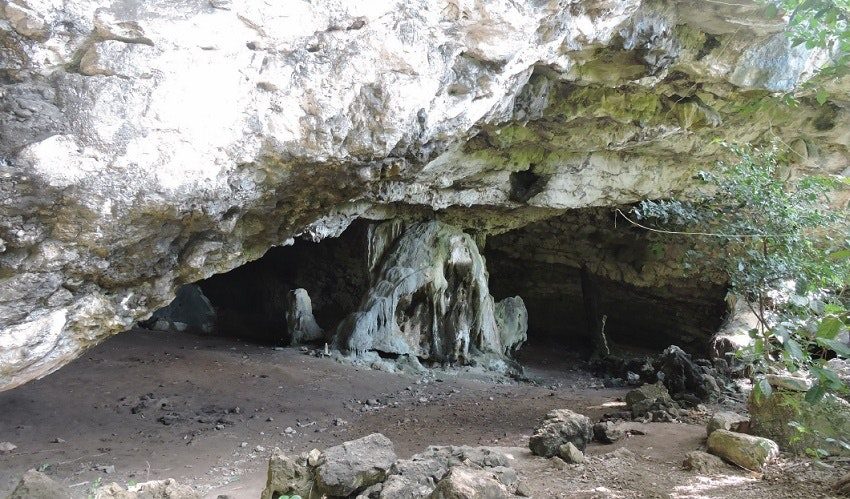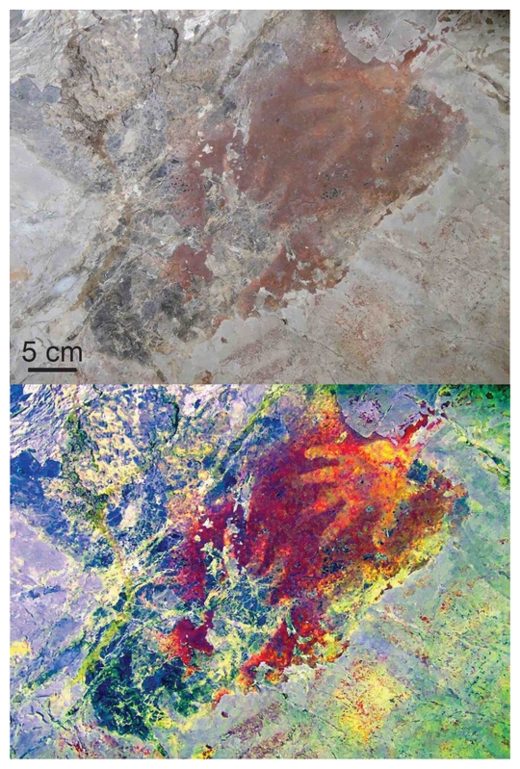
Previously, all known rock art in Timor-Leste - also called East Timor - was thought to be from the Holocene, which began around 11,650 years ago.
Now, a study published in Archaeological Research in Asia reports 16 hand stencils within Lene Hara Cave on Timor-Leste's eastern tip. Archaeologists think they were painted in the Pleistocene epoch, dubbed the "Ice Age", before the Holocene began.
"It was thrilling to rediscover this suite of hand stencils - perhaps the most interesting rock art motifs to study," says the report's lead author Christopher Standish, from the University of Southampton, UK.
"The stencils provide a tangible link to the people who created them; you're looking at the outline of a real person's hand who lived thousands of years ago."
Produced on a mineral crust that has flaked away, the faded patterns are in poor condition and almost imperceptible to the untrained eye. Standish's team was able to identify the hand motifs, however, along with more pigment splatters that were too fragmented to ascertain as stencils.
Close-up photography revealed that the outlines were produced by blowing a red pigment over a hand placed on the cave's surface.
The archaeologists think the stencils have Pleistocene provenance due to tell-tale differences with known Holocene art in the cave, which includes geometric shapes and animals.

Furthermore, all of the stencils were far more weathered and deteriorated than neighbouring Holocene patterns, suggesting a greater antiquity.
"This is consistent with the archaeological evidence from the site which has demonstrated that humans were occupying the cave in the Pleistocene as early as 43,000 years ago," says Standish.
What's more, the hand outlines fit a wider stencilling art tradition present on other nearby islands and Australia.
So what has this got to do with the first colonisers of Australia in the Pleistocene?
Researchers had previously considered two main island-hopping routes - one northern and one southern - that humans could have taken through south-east Asia to reach Australia during the Ice Age around 65,000 years ago.
Back then, sea levels were much lower, and Australia was part of a landmass called Sahul that also comprised Tasmania and New Guinea.
The northern route, beginning from Indonesia's Sulawesi, has more credence because it was likely to be easier. Timor-Leste could have been one of the last island stops on a southern voyage but navigation and dense island vegetation on this route would have posed much more difficulty.
What's more, all known Pleistocene rock paintings in southeast Asia were found on the proposed northern dispersal route, possibly reflecting the path that humans took. No Pleistocene art had ever been found on the southern route, until now.
"The rock art we uncovered could be critical for understanding the colonisation and spread of ideas between Asia and Sahul," says Standish. "The assumption that all known or presumed Pleistocene rock art falls on the northern route is likely to be incorrect."
However, scientifically dating the hand stencils to accurately know when they were made is problematic, because the red pigments used were mineral-based, which rules out carbon dating. Meanwhile, carbonate minerals haven't formed on the stencils, which other isotope dating techniques require.
"There are other known art sites in Timor-Leste that may provide datable samples to help understand this," explains Standish. "There are also likely to be other sites where poorly preserved [Pleistocene] art is present but not currently recognised."
"It is perfectly plausible that Homo sapiens did first disperse and paint rock art along the northern dispersal route, and we aren't arguing against this," Standish adds. "But art on other routes shouldn't be overlooked and attempts to date it are needed if we are to get a full picture of art's emergence in this region."



Reader Comments
to our Newsletter